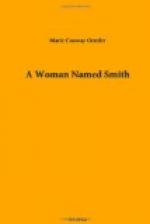CHAPTER VIII
PEACOCKS AND IVORY
“Sophy, do you remember the night we talked it over, and decided to come here, and you were afraid of the new soil’s effect upon yourself?”
“Of course. Why?”
“Oh, because.”
“Because why?”
“Just because.—I wish to gracious you had a little saving vanity, Sophy Smith!”
“And what, then, is this?” I asked ironically, and rustled my skirts. For the Westmacotes were to arrive that night, in time for dinner, and I, standing before the mirror in my room, was what Alicia called “really dressed” for the first time in my life.
“From your point of view, this is a business necessity. From mine, it is applied morality. Why, Sophy, you’re stunning! Here, sit down: I have to loosen up that hair a bit.”
“Now!” said she, when she had critically surveyed her finished work and found it good, “Now, Sophy Smith, you are no longer efficient and utilitarian; you are effective and decorative, thank heaven!”
Really, clothes do make a tremendous difference, after all. Why, I—Well, I no longer looked root-bound.
“I said you’d put out new leaves and begin to bloom!” Alicia exulted. We bowed to the Sophy in the glass, a small and slender person with quantities of fair hair, a round white chin, and steady blue eyes. For the rest, she had a short nose and the rather wide mouth of a boy. She wasn’t what you’d call a beautiful person, but she wasn’t displeasing to the eye.
“Vale, plain Sophy Smith!” cried Alicia, “Ave, dear Lady of Hynds House! We who about to live salute you!”
The Westmacotes were delighted with Alicia. The Head had noticed her just about as much as a Head notices a pale file-clerk in a white shirt-waist and a black skirt. This radiant rose-maiden—“little Dawn-rose,” old Riedriech called her—was new to him; and so, I fancy, was a Miss Smith in such a frock as I was wearing. He, as well as his wife and Miss Phelps-Parsons, accepted us at our face-value, with the background of Hynds House outlining us.
Miss Emmeline Phelps-Parsons was a lady with a soul. She said she had psychic consciousness and a clear green aura, and that she had been an Egyptian priestess in Thebes, in the time of Sesostris. In proof of this she showed us a fine little bronze Osiris holding a whip in one hand and the ankh in the other. ("My dear, the moment I saw him, I knew I had once prayed to him!”) and she always wore a scarab ring. She had bought both in an antique-shop just off Washington Street. I thought this rather a far cry from Thebes, myself, but The Author insisted that if a Theban vestal of the time of Sesostris had to reincarnate, she would naturally and inevitably come to life a Boston one.
The Author hadn’t taken any too kindly to the notion of other people coming to Hynds House. He grumbled that he had hoped he had at last found a quiet haven, a place that fitted him like a glove; he protested piercingly against having it “cluttered up with uninteresting, gobbling, gabbling, ordinary people.”




